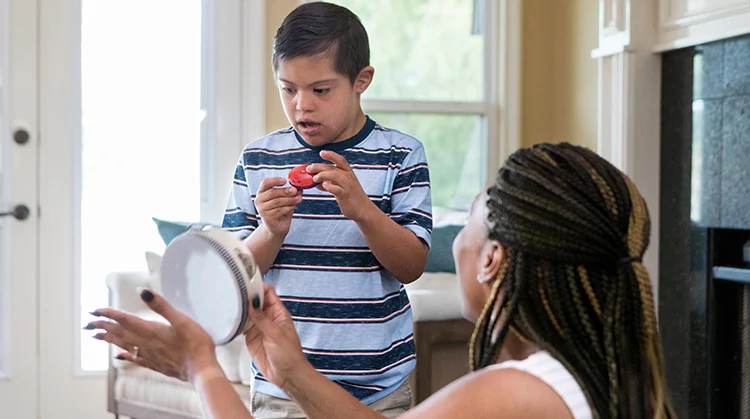Did you know that physical therapy can be beneficial for people with autism? In fact, there are a number of reasons why physical therapy may be a good option for those on the autism spectrum. Today, we’re going to take a closer look at some of the benefits of physical therapy for autism. Keep reading to learn more!
Contents
What Is Autism?
 Autism is something that affects how a person views the world and themselves. Autism spectrum disorder (ASD) is a complex neurobehavioral condition. It is a disorder that causes problems in social interaction, communication, and behaviour. Many people with autism have challenges with verbal and nonverbal communication, which can make it hard to interact with others.
Autism is something that affects how a person views the world and themselves. Autism spectrum disorder (ASD) is a complex neurobehavioral condition. It is a disorder that causes problems in social interaction, communication, and behaviour. Many people with autism have challenges with verbal and nonverbal communication, which can make it hard to interact with others.
Some people with ASD might be overly sensitive to light, sound, or touch. Others might have repetitive behaviours, such as hand-flapping or spinning. Some people with ASD might have little interest in other people and prefer to be alone.
ASD affects each person differently.
What Are The Symptoms Of Autism?

There is no one symptom of autism. The symptoms can range from mild to severe and can vary greatly from person to person. Some people with autism might have only a few symptoms, while others might have many. The most common symptoms of autism include:
Challenges With Social Interaction – such as not looking at people when they are talking, not responding to their name, or avoiding eye contact.
Problem With Communication – such as not speaking or speaking in a flat, monotone voice, or repeating the same phrases over and over.
Repetitive Behaviours – such as hand-flapping, spinning or lining up toys.
Sensitivities To Sights, Sounds, Smells, Tastes, Textures, Or Lights – such as being bothered by loud noises or fluorescent lights.
Delay In Or Lack Of Typical Development Milestones – such as not crawling or walking by 12 months, or not talking in phrases by 24 months.
These symptoms can vary greatly from person to person. Some people with ASD might have only a few symptoms, while others might have many. The severity of the symptoms can also vary from person to person.
Autism spectrum disorder (ASD) is a neurodevelopmental disorder and can be diagnosed in a person as young as 18 months old. The diagnosis of ASD is based on a combination of factors, including clinical observation, family history, and standardized autism assessments.
The few things to see when diagnosing autism are:
- Delay in or lack of spoken language
- Repetitive use of language and/or motor mannerisms (e.g., hand-flapping, spinning)
- Little or no eye contact
- Lack of interest in peer relationships
- Persistent fixations on parts of objects
If you think that your child may have ASD, it is important to consult with a healthcare professional as soon as possible. An early diagnosis and intervention can make a big difference in the lives of children with ASD and their families.
Different Treatments Available For Autism
There are many different types of treatments available for autism, from therapies to medications. The most common treatments include:
- Behavioural therapy: Behavioral therapy helps those on the autism spectrum learn to manage their behaviours and improve communication skills.
- Speech therapy: Speech therapists can help those on the autism spectrum improve communication skills and social interaction. This may involve teaching specific language skills or strategies to help with problem-solving and understanding others.
- Dietary therapies: Dietary changes can help some people with autism manage symptoms more effectively. This may involve eliminating certain foods, such as dairy or gluten, or supplementing with vitamins and minerals.
- Occupational therapy: Occupational therapists help those on the autism spectrum learn to perform everyday tasks more effectively. This may involve using assistive technology or teaching strategies to help with fine motor skills, communication, and behaviour.
- Physical therapy: Physical therapy helps those on the autism spectrum improve gross and fine motor skills, balance, coordination, strength, and endurance. It can also provide a sense of calm and relaxation for those with autism.
- Family therapy: Family therapy is designed to help families better understand how to support their child on the autism spectrum. This may involve education about autism and communication strategies that can help the whole family.
- Medication: Some medications used for autism include antipsychotics, antidepressants, stimulants, and anti-anxiety medications.
Each therapy has its own unique set of benefits and it’s important to speak with your doctor or therapist to determine which one is right for you.
Overall, physical therapy can be a great addition to an autism treatment plan. It can help improve motor skills, coordination, balance, strength, and communication. The calming effects of physical therapy can also help reduce anxiety and stress for those on the autism spectrum.
Benefits Of Physical Therapy For Autism

The benefits of physical therapy for autism are many. Let us discuss them one by one:
1. Helps in Improving Motor Skills: Autism spectrum disorder (ASD) is often accompanied by impaired motor skills. Physical therapy can help these children develop stronger muscles and improve their coordination.
2. Reduces Sensory Issues: Many autistic children have sensory processing issues. They may be oversensitive to touch, smell, sound, and light. Physical therapy can help them become more comfortable with different sensations and learn to cope with them.
3. Improves Balance and coordination: Autism often leads to impaired balance and coordination. Physical therapy can help these children improve their balance and coordination skills.
4. Helps in Social Interaction: Autism spectrum disorder (ASD) often leads to social withdrawal. Physical therapy can help autistic children interact better with their peers and develop social skills.
5. Improves Communication Skills: Autism spectrum disorder (ASD) often leads to communication difficulties. Speech therapy combined with physical therapy can help these children improve their communication skills.
6. Reduces Behavioural Issues: Autism spectrum disorder (ASD) is often accompanied by behavioural issues such as tantrums, aggression, and self-injurious behaviour. Physical therapy can help reduce these behaviours.
7. Improves Overall Health: Physical therapy not only improves the physical health of autistic children but also their overall health. Regular exercise can help boost their immune system and improve their sleep patterns.
Physical therapy can help autistic children in many ways. If you have an autistic child, consider taking them to a physical therapist.
Most Common Physical Therapy For Autism
There are many physical therapies that can be used to help people with autism. Some of the most common physical therapies for autism include:
Massage Therapy: Massage therapy can help to relax muscles and improve circulation. It can also help to reduce anxiety and stress.
Exercise: Exercise can help to improve flexibility, strength, and endurance. It can also help to improve balance and coordination. These exercises include:
Balance Training: Balance training can help to improve balance and coordination. It can also help to reduce the risk of falls.
Flexibility Training: Flexibility training can help to improve the range of motion and reduce stiffness.
Strength Training: Strength training can help to build muscle and improve strength.
Cardiovascular Training: Cardiovascular training can help to improve heart and lung health. It can also help to reduce the risk of obesity.
Aquatic Therapy: Aquatic therapy can help to improve the range of motion, flexibility, and strength. It can also help to reduce pain and swelling.
Yoga: Yoga can help to improve flexibility, strength, and endurance. It can also help to improve balance and coordination.
Tai chi: Tai chi can help to improve flexibility, strength, and endurance. It can also help to improve balance and coordination.
Pilates: Pilates can help to improve flexibility, strength, and endurance. It can also help to improve balance and coordination.
Conclusion
In conclusion, physical therapy for autism can be extremely beneficial for those on the autism spectrum. It can help with gross and fine motor skills, communication, and behaviour. Physical therapy can also provide a sense of calm and relaxation for those with autism. If you are considering physical therapy for your child with autism, be sure to speak with your doctor or a qualified physical therapist to get started.
Physical Therapy help patients recover from pain. If you’re experiencing Back pain, Shoulder pain, Knee pain, Neck pain, Elbow pain, Hip pain, or Arthritis pain, a physical therapist at MantraCare can help: Book a physiotherapy session.


